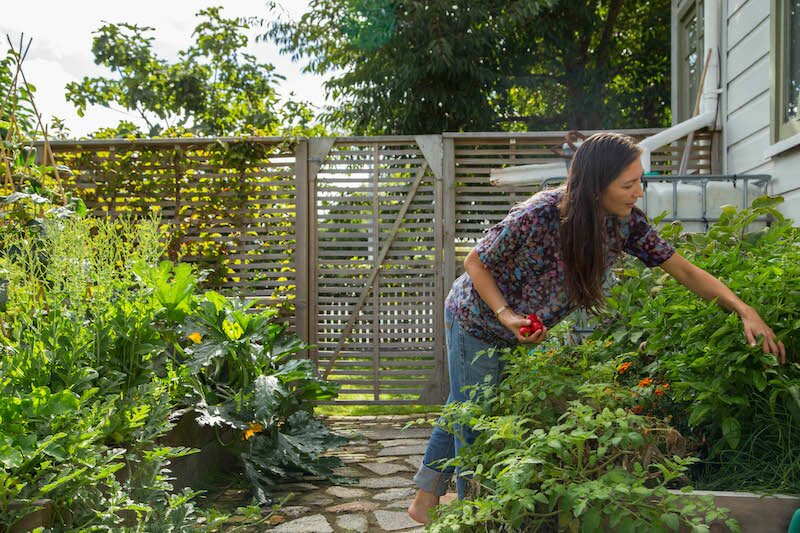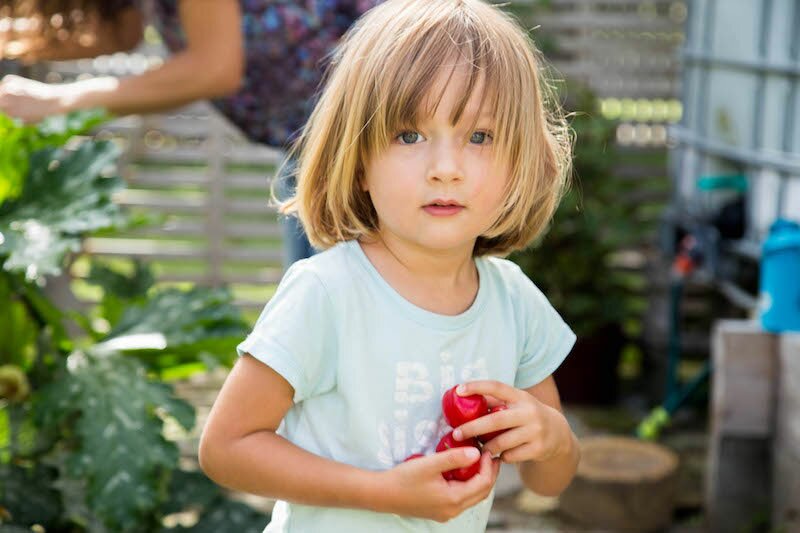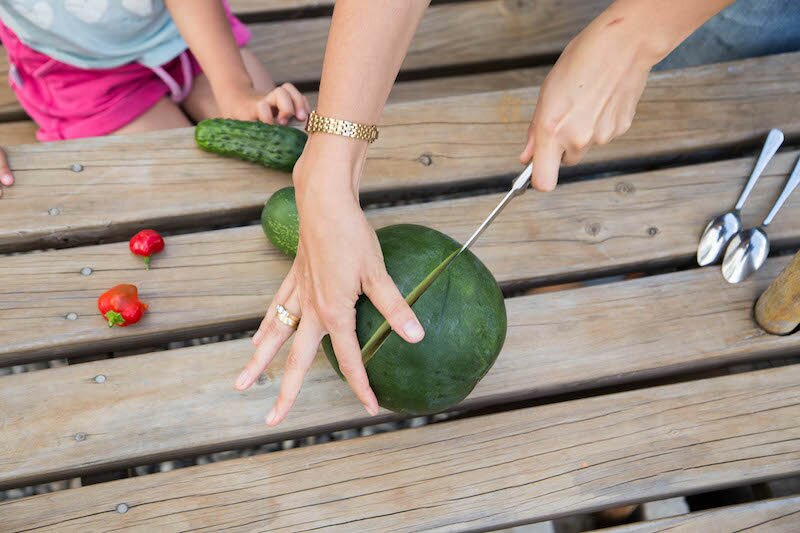Before we had children, I was one of those people who had an idea that organic might be better but I actually preferred not to know any hard facts or scary details relating to the difference between organic and non-organic food because the fact is, organic foods cost significantly more than their mainstream alternatives. And I couldn’t afford that difference. So I felt like it was better not to know. Ignorance is bliss.
Then we had our first child. And I couldn’t breastfeed her. We gave her formula and it was difficult; the problems went away with a switch to goats’ milk formula, almost overnight. I started reading around out of interest, and learned more about the inferiority of infant formula when compared to breastmilk. So, I’ll admit, my decision to invest more money into organic food was a little bit motivated by guilt and a desire to make it up to her. Bit by bit, as we could afford, I introduced organic food into our kitchen, and when that wasn’t an option I settled for locally produced, pesticide-free, and/or fair trade options.
When it came time for me to stop work in preparation for the arrival of our No.2, my husband and I sat down to review our household budget. We were nervous about calculating our outgoing expenses, predicting our switch to expensive organic foods over the past year had blown our old budget out of the water. We were both really surprised to discover that our spending hadn’t actually increased that much at all! We were also quite shocked to learn that our household spending was very average according to NZ-wide statistics. We could only explain it by rationalising that where our spending had increased significantly with food, it had proportionally decreased significantly in other areas of housekeeping such as cleaning and toiletries. This did, and still does, sit very comfortably with our values, which we have considered more carefully in recent years: What’s the point in having both of us work so hard to earn money that can only afford an average lifestyle that leaves us feeling average? Is this really as good as it can be? What’s more important in life than good health and good relationships? (Often made and/or nurtured over the dinner table 😉 ). How can we fully enjoy our harvest, when it’s been reaped at the expense of others?
Since we have really committed to our ethical, sustainable, as-organic-as-we-can-afford lifestyle, we have been open to learning more about the many benefits of eating organic food (and it’s not just about the ingestion of synthetic chemicals) and the scary truths about how mainstream food is produced. Some people believe that organic food is just a hype, like “chemophobia” – the classic joke, “Dihydrogen monoxide: fatal if inhaled, capable of causing severe burns, a major component of most tumours. …also known as H2O,” is seen by some as a reassurance that scary-sounding chemicals are probably perfectly harmless. I don’t deny that I am choosing one scary-sounding chemical over another scary-sounding chemical when I soak our clothes in sodium percarbonate over sodium hypochlorite. But I don’t understand why anyone would want to use (eat) chemicals that are known to be detrimental to the environment and/or our health, or run the risk of being so, when their use isn’t even necessary? What’s the point in having more and more sophisticated technology if we’re not going to use it or the information it reveals because some company is inflexible in its manufacturing process (often relating to money, power, and/or arrogance)? When you have two healthy children, it just doesn’t seem worth the risk, especially when there are alternatives.
Many people have no choice or little choice about what they can buy and use, so I am motivated by the belief that people like me who have access to information, the ability to process it, and the means to afford conscious consumerism have a responsibility to make the right choices and through our numbers change what is considered the norm for everyone. I have lived through a time when McDonald’s power exceeded international law, and yet within a period of a few years it was forced to change its whole menu, its image, its attitude towards public health, simply in response to overwhelming public pressure generated by people like us.
So, how does my family afford such a responsibility? There is no denying that the hefty price tags on high quality, organic food cause many a conscientious shopper to wince and walk on.
Here’s how we do it:

1. We grow our own food as much as possible. This year we farewelled a couple of square metres of lawn space and built a second vege garden so we could grow more food. I’ve also stopped buying decorative trees and shrubs in favour of fruiting trees that are strong, productive, and manageable in terms of maintenance and harvesting.
2. We are learning to use everything from our garden – for example, I’ve just discovered I can make broccoli leaf chips (which are delicious!). I also tried stir frying beetroot leaves (also delicious). Next summer I’ll try zucchini flowers, borage and nasturtium flowers. We compost the rest, and we compost almost all our food scraps so we can then use it to feed the garden affordably! I am interested in looking into worm farms too…
3. I’ve started learning how to preserve food through fermentation, pickling, jam-making, and fruit preserves. Fruit, in particular, often drops from the tree in a deluge (!) so you need to figure out ways to preserve what you can’t eat immediately, meaning you can still enjoy variety and the benefits of fruit when it’s in short supply.
4. We are devoted customers of our local Farmers’ Market. Some weekends it’s a real effort getting there, especially when it’s raining hard, freezing cold, and our comfortable house is snugly warm. But we have forced ourselves to go for long enough that it’s now a habit we don’t even consider breaking anymore. We are motivated by the good feelings that come from knowing that all the money we spend ends up in the hands of the (good) people who invested their energy into producing our food. Most of the food we buy there isn’t actually certified organic, but we have been able to talk to the sellers about their farming practices and we can buy produce and meat that we feel are sustainably and ethically sourced. We look for spray-free veges/fruit (we specifically ask about RoundUp), antibiotic-free, free-ranging/grazing animal products, and plastic-free packaging (sometimes negotiated!). We trust the stall holders, because we have an ongoing relationship with them based on interdependence. We eat meat knowing the farmer has a responsible relationship with his beasts, and he is resourceful without being irresponsible. We have found that their prices are often comparable to supermarket prices, but with all the proceeds making it into the farmers’ hands.
5. I make food from scratch. Lately, I’ve been having fun growing and learning to use my sourdough starter to make bread (and pancakes!) so I don’t need to use instant yeast. I can make organic bread affordably this way. I make (mostly organic) basil pesto, organic sauerkraut, and organic jam.
6. The biggest cost saver has been in reducing our use of commercially-prepared cleaning supplies and toiletries – the money we’ve saved here has been redistributed to our food budget.
7. We are starting to buy organic in bulk – this also cuts down on plastic packaging. Some things we now buy in bulk or from bulk bins are organic virgin coconut oil, flours, rice, raisins, and coffee.
8. We are starting to swap food with other people. When I make sauerkraut, I do about 4L at a time. Jam-making sessions always result in jars and jars of jam. Dumping excess sourdough starter seems silly when a friend would happily take a loaf of organic bread off my hand! So we’re starting to get into swapping (and giving) with friends and family.
9. I’m also learning to substitute foods. For example, we now buy organic butter. Well, organic butter is eye-wateringly expensive! So, I make a table spread of coconut oil (and avocado/olive oils when it’s cold) for our toast instead of butter. I fry with lard when I can, because it’s more affordable than butter. Butter gets saved for frying steak and mushrooms, baking (sourdough pancakes… om nom nom!), and on toast when you’re going to follow it with homemade jam – yum!
Yes, these things take time. And a great deal of effort. But we figure out a way to make that time and inject that effort because we’ve decided that “Good” food is a priority for us. And we LOVE eating our hard work, and watching our kids enjoy it too.

